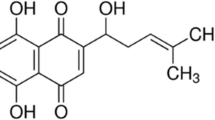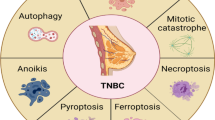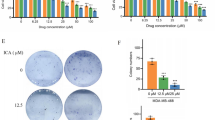Abstract
Objective
To explore the effect and mechanism of action of bufalin in triple-negative breast cancer (TNBC) drug-resistant cell lines.
Methods
The normal human mammary epithelial cell line, TNBC cell line, TNBC adriamycin-resistant cell line, and TNBC docetaxel-resistant cell line were treated with different doses of bufalin (0–1,000 nmol/L) at different time points (0–72 h). Propidium iodide staining, AV-FITC/PI double staining, Hoechst 33342/PI double staining and transmission electron microscopy (TEM) were used to evaluate the death patterns of the cell lines.
Results
Bufalin killed the TNBC cell line and its drug-resistant cell lines in a dose/time-dependent manner (all P<0.01). After treatment with bufalin for 24 h, the adriamycin-resistant cell line showed a co-existing pattern of necroptosis and apoptosis. However, at 48 h, necroptosis was the main manifestation. After treatment with bufalin, the expressions of tumor necrosis factor α, phospho-tumor necrosis factor receptor 1, phospho-receptor interacting protein 1 and c-caspase 3 increased (all P<0.01), the killing effect of bufalin could be mostly inhibited by NEC-1, and by z-VAD-fmk (both P<0.01). Besides, the intracellular reactive oxygen species (ROS) levels increased considerably (P<0.01), the antioxidant N-acetyl cysteine or Nec-1 could inhibit the increase of ROS level and the killing effect of bufalin (all P<0.01). The adriamycin-resistant cell line exhibited necroptosis characteristic after 48 h of bufalin treatment under TEM.
Conclusions
Bufalin could induce necroptosis through RIP1/ROS-mediated pathway to kill the drug-resistant TNBC cell lines. This finding provides critical experimental data and theoretical basis for the clinical application of bufalin to overcome the difficulties in the treatment of TNBC.
Similar content being viewed by others
References
Liedtke C, Rody A. New treatment strategies for patients with triple-negative breast cancer. Curr Opin Obstet Gynecol 2015;27:77–84.
Ferguson LL, Curran B, Martinez M, Mancuso P. Triple-negative breast cancer: what is known about it? Clin J Oncol Nurs 2014;18:E6–E11.
Cortazar P, Zhang L, Untch M, Mehta K, Costantino JP, Wolmark N, et al. Pathological complete response and long-term clinical benefit in breast cancer: the CTNeoBC pooled analysis. Lancet 2014;384:164–172.
Ellis LM, Bernstein DS, Voest EE, Berlin JD, Sargent D, Cortazar P, et al. American Society of Clinical Oncology perspective: Raising the bar for clinical trials by defining clinically meaningful outcomes. J Clin Oncol 2014;32:1277–1280.
Gimenez-Bonafe P, Tortosa A, Perez-Tomas R. Overcoming drug resistance by enhancing apoptosis of tumor cells. Curr Cancer Drug Targets 2009;9:320–340.
Viktorsson K, Lewensohn R, Zhivotovsky B. Apoptotic pathways and therapy resistance in human malignancies. Adv Cancer Res 2005;94:143–196.
Krysko O, Aaes TL, Kagan VE, D’Herde K, Bachert C, Leybaert L, et al. Necroptotic cell death in anti-cancer therapy. Immunol Rev 2017;280:207–219.
Hu X, Xuan Y. Bypassing cancer drug resistance by activating multiple death pathways—a proposal from the study of circumventing cancer drug resistance by induction of necroptosis. Cancer Lett 2008;259:127–137.
Ondrouskova E, Soucek K, Horvath V, Smarda J. Alternative pathways of programmed cell death are activated in cells with defective caspase-dependent apoptosis. Leuk Res 2008;32:599–609.
Saddoughi SA, Gencer S, Peterson YK, Ward KE, Mukhopadhyay A, Oaks J, et al. Sphingosine analogue drug FTY720 targets I2PP2A/SET and mediates lung tumour suppression via activation of PP2A-RIPK1-dependent necroptosis. EMBO Mol Med 2013;5:105–121.
Hu X, Han W, Li L. Targeting the weak point of cancer by induction of necroptosis. Autophagy 2007;3:490–492.
Fu Z, Deng B, Liao Y, Shan L, Yin F, Wang Z, et al. The antitumor effect of shikonin on osteosarcoma by inducing RIP1 and RIP3 dependent necroptosis. BMC Cancer 2013;13:580.
Grassilli E, Narloch R, Federzoni E, Ianzano L, Pisano F, Giovannoni R, et al. Inhibition of GSK3B bypass drug resistance of p53-null colon carcinomas by enabling necroptosis in response to chemotherapy. Clin Cancer Res 2013;19:3820–3831.
Steinhart L, Belz K, Fulda S. Smac mimetic and demethylating agents synergistically trigger cell death in acute myeloid leukemia cells and overcome apoptosis resistance by inducing necroptosis. Cell Death Dis 2013;4:e802.
Yan S, Qu X, Xu L, Che X, Ma Y, Zhang L, et al. Bufalin enhances TRAIL-induced apoptosis by redistributing death receptors in lipid rafts in breast cancer cells. Anticancer Drugs 2014;25:683–689.
Cao H, Shibayama-Imazu T, Masuda Y, Shinki T, Nakajo S, Nakaya K. Involvement of Tiam1 in apoptosis induced by bufalin in HeLa cells. Anticancer Res 2007;27:245–249.
Zhang DW, Shao J, Lin J, Zhang N, Lu BJ, Lin SC, et al. RIP3, an energy metabolism regulator that switches TNF-induced cell death from apoptosis to necrosis. Science 2009;325:332–336.
Zhu Z, Li E, Liu Y, Gao Y, Sun H, Ma G, et al. Inhibition of Jak-STAT3 pathway enhances bufalin-induced apoptosis in colon cancer SW620 cells. World J Surg Oncol 2012;10:228.
Lan YL, Wang X, Lou JC, Xing JS, Yu ZL, Wang HJ, et al. Bufalin inhibits glioblastoma growth by promoting proteasomal degradation of the Na+/K+-ATPase alpha 1 subunit. Biomed Pharmacother 2018;103:204–215.
Huang HB, Zhang W. Bufalin induced apoptosis of bladder carcinoma cells through the inactivation of Na plus K plus-ATPase. Oncol Lett 2018;16:3826–3832.
Yu Z, Feng H, Sun XH, Zhuo YH, Li M, Zhou ZH, et al. Bufalin suppresses hepatocarcinogenesis by targeting beta-catenin/TCF signaling via cell cycle-related kinase. Sci Rep 2018;8:3891.
Ding Y, Liu W, Wang XL, Zhang LL, Zhao M, Deng HY, et al. Bufalin induces apoptosis in human esophageal carcinoma ECA109 cells by inhibiting the activation of the mTOR/p70S6K pathway. Oncol Lett 2018;15:9339–9346.
Xie JL, Lin WF, Huang LL, Xu NJ, Xu A, Chen BS, et al. Bufalin suppresses the proliferation and metastasis of renal cell carcinoma by inhibiting the PI3K/Akt/mTOR signaling pathway. Oncol Lett 2018;16:3867–3873.
Li Y, Tian X, Liu X, Gong P. Bufalin inhibits human breast cancer tumorigenesis by inducing cell death through the ROS-mediated RIP1/RIP3/PARP-1 pathways. Carcinogenesis 2018;39:700–707.
Li Y, Gong P, Kong C, Tian X. Bufalin engages in RIP1-dependent and ROS-dependent programmed necroptosis in breast cancer cells by targeting the RIP1/RIP3/PGAM5 pathway. Anticancer Drugs 2019;30:e0770.
Syed Abdul Rahman SN, Abdul Wahab N, Abd Malek SN. In vitro morphological assessment of apoptosis induced by antiproliferative constituents from the rhizomes of Curcuma zedoaria. Evid Based Complement Alternat Med 2013;2013:257108.
Rastogi RP, Singh SP, Hader DP, Sinha RP. Detection of reactive oxygen species (ROS) by the oxidant-sensing probe 2’,7’-dichlorodihydrofluorescein diacetate in the cyanobacterium Anabaena variabilis PCC 7937. Biochem Biophys Res Commun 2010;397:603–607.
Kassam F, Enright K, Dent R, Dranitsaris G, Myers J, Flynn C, et al. Survival outcomes for patients with metastatic triple-negative breast cancer: implications for clinical practice and trial design. Clin Breast Cancer 2009;9:29–33.
Meng ZQ, Yang PY, Shen YH, Bei WY, Zhang Y, Ge YQ, et al. Pilot study of Huachansu in patients with hepatocellular carcinoma, nonsmall-cell lung cancer, or pancreatic cancer. Cancer-Am Cancer Soc 2009;115:5309–5318.
Dong YH, Yin ST, Li JH, Jiang C, Ye M, Hu HB. Bufadienolide compounds sensitize human breast cancer cells to TRAIL-induced apoptosis via inhibition of STAT3/Mcl-1 pathway. Apoptosis 2011;16:394–403.
Dondelinger Y, Jouan-Lanhouet S, Divert T, Theatre E, Bertin J, Gough PJ, et al. NF-kappaB-independent role of IKKalpha/IKKbeta in preventing RIPK1 kinase-dependent apoptotic and necroptotic cell death during TNF signaling. Mol Cell 2015;60:63–76.
Zhou W, Yuan J. Necroptosis in health and diseases. Semin Cell Dev Biol 2014;35:14–23.
Turrens JF. Mitochondrial formation of reactive oxygen species. J Physiol-London 2003;552:335–344.
Iijima T, Mishima T, Akayawa K, Huaa Y. Neuroprotective effect of propofol on necrosis and apoptosis following oxygen-glucose deprivation-relationship between mitochondrial membrane potential and mode of death. Brain Res 2006;1099:25–32.
Dubin M, Stoppani AOM. Programmed cell death and apoptosis. The role of mitochondria. Medicina-Buenos Aire 2000;60:375–386.
Zhang M, Harashima N, Moritani T, Huang W, Harada M. The roles of ROS and caspases in TRAIL-induced apoptosis and necroptosis in human pancreatic cancer cells. PLoS One 2015;10:e0127386.
Mareninova OA, Odinokova IV, Lee MA, Gukovsky I, Gukovskaya AS. Role of mitochondrial permeability transition pore in pancreatitis. Gastroenterology 2009;136:A60.
Hu Q, Liang B, Sun Y, Guo XL, Bao YJ, Xie DH, et al. Preparation of bufalin-loaded pluronic polyetherimide nanoparticles, cellular uptake, distribution, and effect on colorectal cancer. Int J Nanomed 2014;9:4035–4041.
Liu M, Feng LX, Sun P, Liu W, Wu WY, Jiang BH, et al. A novel bufalin derivative exhibited stronger apoptosis-inducing effect than bufalin in A549 lung cancer cells and lower acute toxicity in mice. PLos One 2016;11:e0159789.
Sun P, Feng LX, Zhang DM, Liu M, Liu W, Mi T, et al. Bufalin derivative BF211 inhibits proteasome activity in human lung cancer cells in vitro by inhibiting beta 1 subunit expression and disrupting proteasome assembly. Acta Pharmacol Sin 2016;37:908–918.
Author information
Authors and Affiliations
Contributions
Liu XD, Song CY and Kong CC performed the experiments; Tian X designed the experiments and drafted the manuscript. All authors read and approved the final version of the manuscript for publication.
Corresponding author
Additional information
Conflict of Interest
The authors declare no financial or commercial conflict of interest.
Supported by the National Natural Science Foundation of China (No. 81573654)
Electronic supplementary material
Rights and permissions
About this article
Cite this article
Liu, Xd., Song, Cy., Kong, Cc. et al. Bufalin Induces Programmed Necroptosis in Triple-Negative Breast Cancer Drug-Resistant Cell Lines through RIP1/ROS-Mediated Pathway. Chin. J. Integr. Med. 28, 900–908 (2022). https://doi.org/10.1007/s11655-021-3458-7
Accepted:
Published:
Issue Date:
DOI: https://doi.org/10.1007/s11655-021-3458-7




